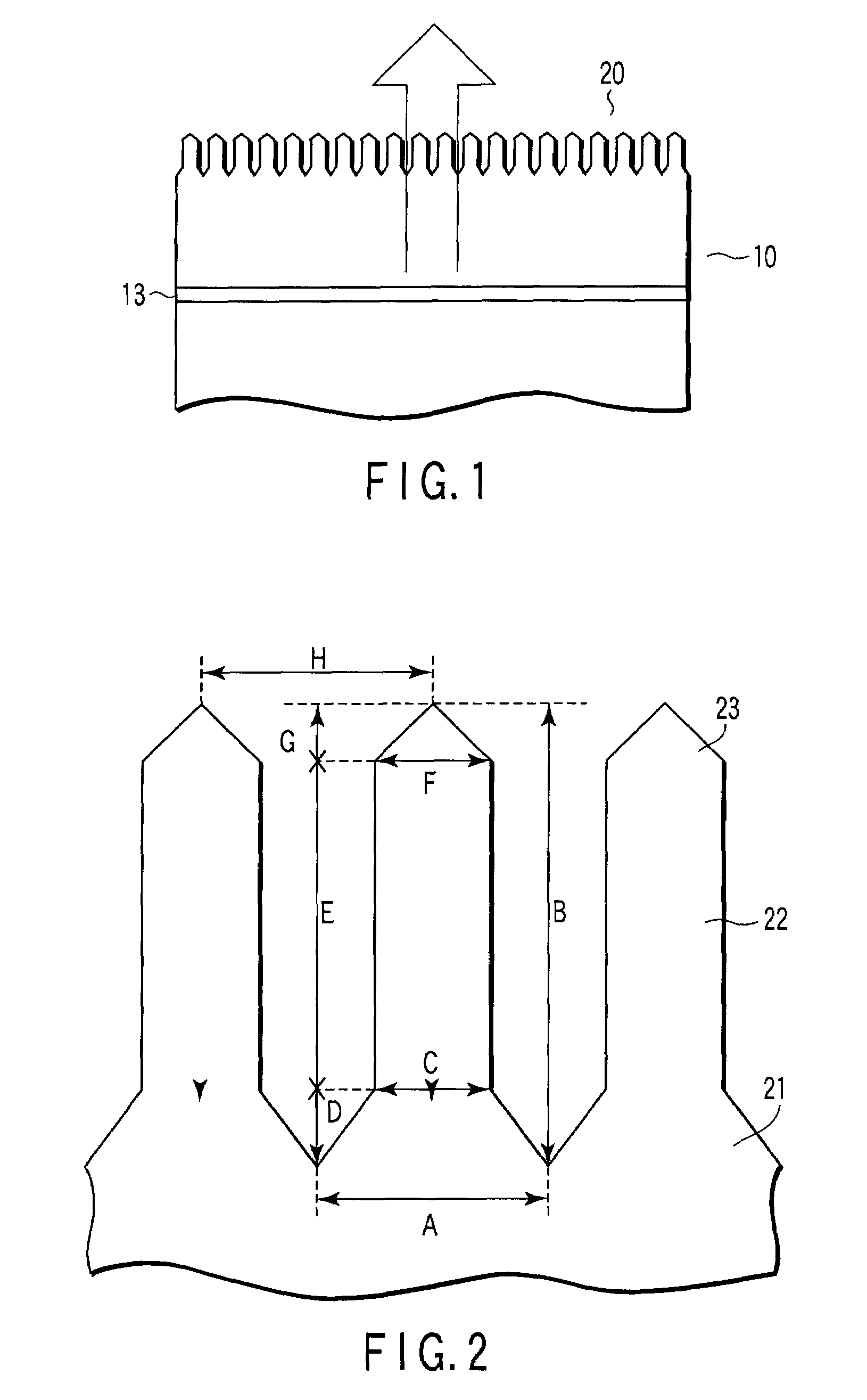Semiconductor light emitting device and method for manufacturing the same
a technology of semiconductors and light emitting devices, which is applied in the direction of semiconductor devices, basic electric elements, electrical equipment, etc., can solve the problems of low productivity, high manufacturing cost of structure fabrication, and insufficient effect of structur
- Summary
- Abstract
- Description
- Claims
- Application Information
AI Technical Summary
Problems solved by technology
Method used
Image
Examples
example 1
[0109]FIG. 3 is a sectional view showing the element structure of a light emitting diode according to a first example of the present invention.
[0110]A double hetero structure is formed on the n-GaP substrate 11; the double hetero structure has the InGaAlP active layer 13 sandwiched between the n-InAlP clad layer 12 and the p-InAlP clad layer 14. The GaP current diffusion layer 15 is formed on the double hetero structure. The p-side electrode 16 is formed on a part of the p-GaP current diffusion layer 15. The n-side electrode 17 is formed on a part of the bottom surface of the n-GaP substrate 11. Thus, a light emitting diode of emitting wavelength 650 nm is formed.
[0111]In this case, instead of GaP, GaAs may be used as the substrate 11. Instead of GaP, InAlP or InGaAlP may be used as the current diffusion layer 15. Of course, the substrate may be of the p type and the entire conductivity type may be reversed.
[0112]The convex structures 20, characteristic of the present example, are f...
example 2
[0121]A phase-separated substrate with a block copolymer produced as described in Example 1 was dry etched by RIE at an O2 flow rate of 30 sccm, a pressure of 13.3 Pa (100 mTorr), and a power of 100 W to etch PS and PMMA, separated from each other. O2 etching cannot etch the substrate in contrast to CF4 etching but can selectively etch PMMA. Subsequently, by a process similar to that in Example 1 fine concaves and convexes having conical, cylindrical, and mesa portions was formed.
[0122]On this occasion, the average diameter of the bottom of the mesa portion 21 was 160 nm. The average diameter of the top of the mesa portion 21 was 100 nm. The average height of the mesa portion 21 was 70 nm. The average diameter of the cylindrical portion 22 was 100 nm. The average height of the cylindrical portion 22 was 250 nm. The average diameter of the conical portion 23 was 100 nm. The average height of the conical portion 23 was 80 nm. The period between the convex structures was 180 nm.
[0123]A...
example 3
[0124]The spin coat method was used to coat a solution, at 3,000 rpm, on the current diffusion layer 15, the uppermost layer of the light emitting element formation substrate 10, used in Example 1; the solution was obtained by dissolving a block copolymer containing PS of molecular weight 315,000 and PMMA of molecular weight 785,000. Subsequently, the light emitting element substrate 10 was pre-baked at 110° C. for 90 seconds to vaporize the solvent. A thickness of 150 nm was thus obtained. Then, in a nitrogen atmosphere, the block copolymer film was annealed at 210° C. for four hours to separate PS from PMMA. A PS dot pattern of diameter about 110 nm was formed.
[0125]The phase-separated GaP substrate with the block copolymer was dry etched by RIE at an O2 flow rate of 30 sccm, a pressure of 13.3 Pa (100 mTorr), and a power of 100 W to etch PS and PMMA, separated from each other. O2 etching cannot etch the substrate but can selectively etch PMMA. Since the etching rate ratio of PS t...
PUM
 Login to View More
Login to View More Abstract
Description
Claims
Application Information
 Login to View More
Login to View More - R&D
- Intellectual Property
- Life Sciences
- Materials
- Tech Scout
- Unparalleled Data Quality
- Higher Quality Content
- 60% Fewer Hallucinations
Browse by: Latest US Patents, China's latest patents, Technical Efficacy Thesaurus, Application Domain, Technology Topic, Popular Technical Reports.
© 2025 PatSnap. All rights reserved.Legal|Privacy policy|Modern Slavery Act Transparency Statement|Sitemap|About US| Contact US: help@patsnap.com



